Suffolk Council Council as part of Transport East, who represent Suffolk, Norfolk, and Essex highways and transport authorities, are looking to reduce the carbon emissions of transport in the region.
Here’s some of my ideas of what could be done to reduce the carbon emissions in the region.
Local
The majority of journeys people make are short, under 5-10 miles, and so are ideal candidates for changing from private motor vehicles to walking, cycling, public transport, or other active travel modes such as scooters. It’s also one of the area that can have a huge impact with several things such as reducing carbon emissions, improving air quality and the health of people in the county. Just small reductions in motor traffic can have a big impact on congestion, you can see this by comparing the school term time vs school holiday traffic levels.
DfT stats on journey length, distance, etc.
Low Traffic Neighbourhoods
Over the past decade with the introduction of the mobile phone and sat nav with dynamic routing, the level of motor traffic on minor roads and residential streets has doubled. Many new rat runs have been introduced with no consultation, with air pollution and road danger ever increasing on what should be quiet residential roads. Previously people would use an old style map to navigate, and in doing so would generally keep to the main roads.
As shown in the graph below, there has been an increase in motor traffic at the regional level over the past few decades, more detailed data analysis of the raw DfT traffic data, over the past few decades is required within urban areas. The partly rural nature is likely to mean that people are able to get on to the faster A roads much quicker, thus less of an increase is shown on local roads at the regional level, but could be more evident at the local level within urban areas, like has happened in London.
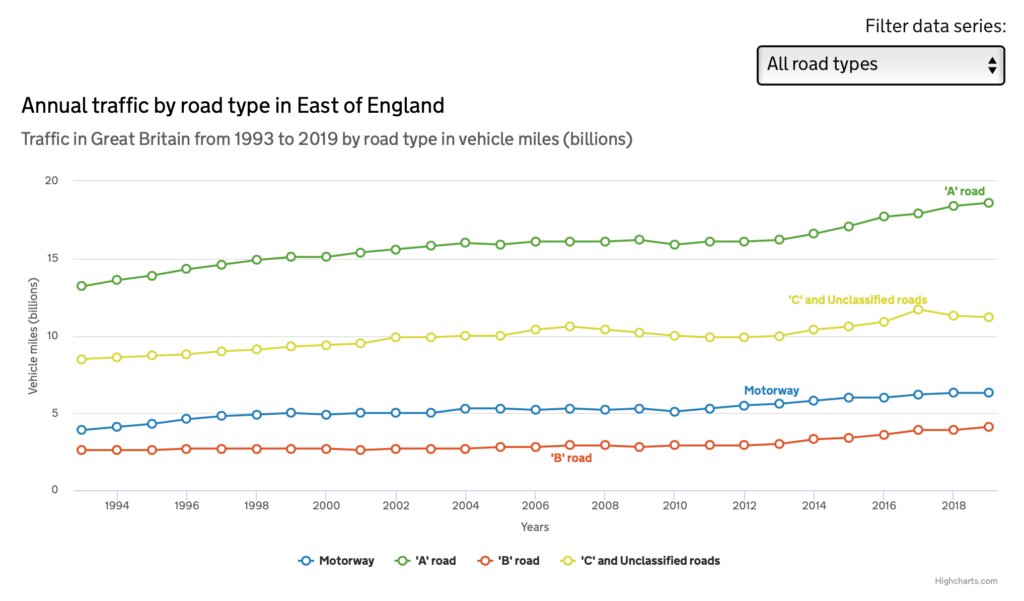
The count points can be seen in the map below for the Ipswich area:
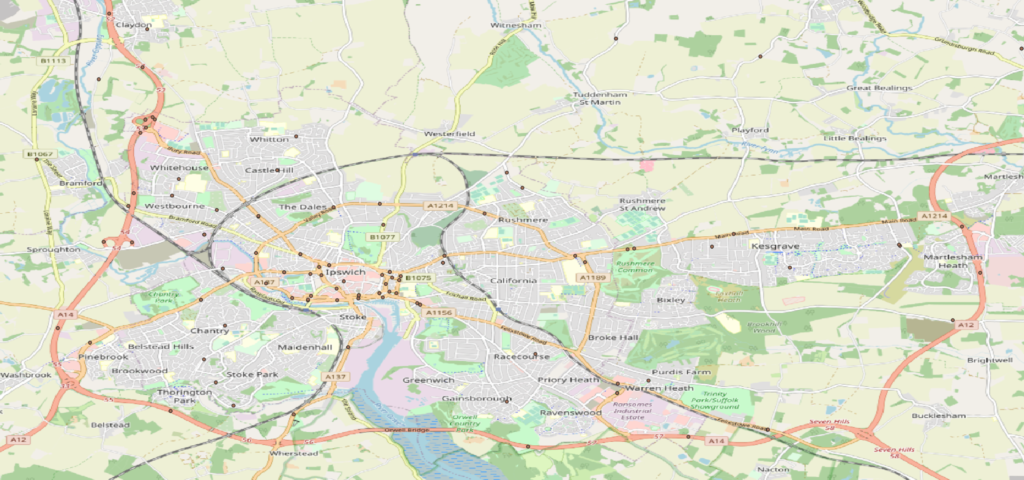
In London the change in motor traffic is much more pronounced on minor roads showing a near doubling in motor traffic over the past decade. The level of motor traffic on A roads has stayed fairly steady, this is due to the though motor traffic spilling on to local residential roads. I see no reason why this should be any different in other towns and cities such as Ipswich. The main cause of the change is the introduction of the smart phone with dynamic journey routing in mapping apps. Sadly some of the optimisations are shaving a few minutes here or there by getting people cutting through residential streets.
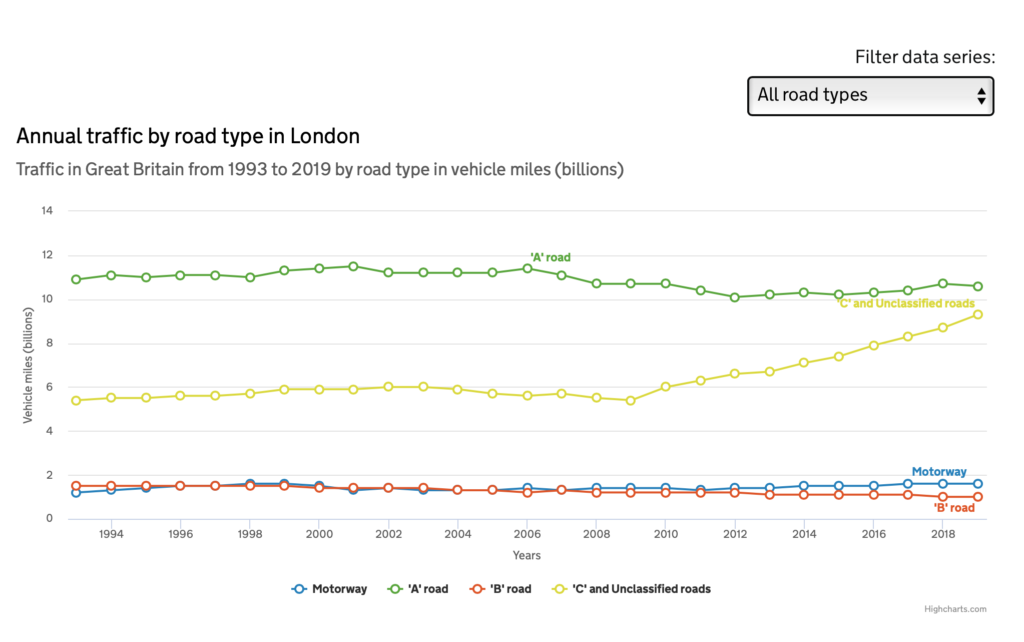
Low Traffic Neighbourhoods are an excellent way to generate modal shift on short journeys from the private motor vehicles to more active and less polluting modes of transport. Research by Rachel Aldred and Anna Goodman shows that low traffic neighbourhoods reduce car use, car ownership, and increase the levels of active travel. They are a key component to reducing the carbon emissions from transport.
Low Traffic Neighbourhoods, or to give them another name active neighbourhoods are not a magic pill that magically transforms them overnight. They take several months for things to bed in and people to get used to the changed layout of the streets and for a the modal shift to happen. There is some pain during the initial phase, however once implemented and in place for 6-18 months it’s rare to find residents asking for them to be removed.
There already exists some areas of Ipswich which meet the basic principles of a low traffic neighbourhood. I’m not aware of any campaigns to open up the streets to more motor traffic as people like to live on quiet streets. For example the area between Bramford Road and London Road only allows through motor vehicle access at one point, go the other direction, and you will have a significant detour in a motor vehicle.
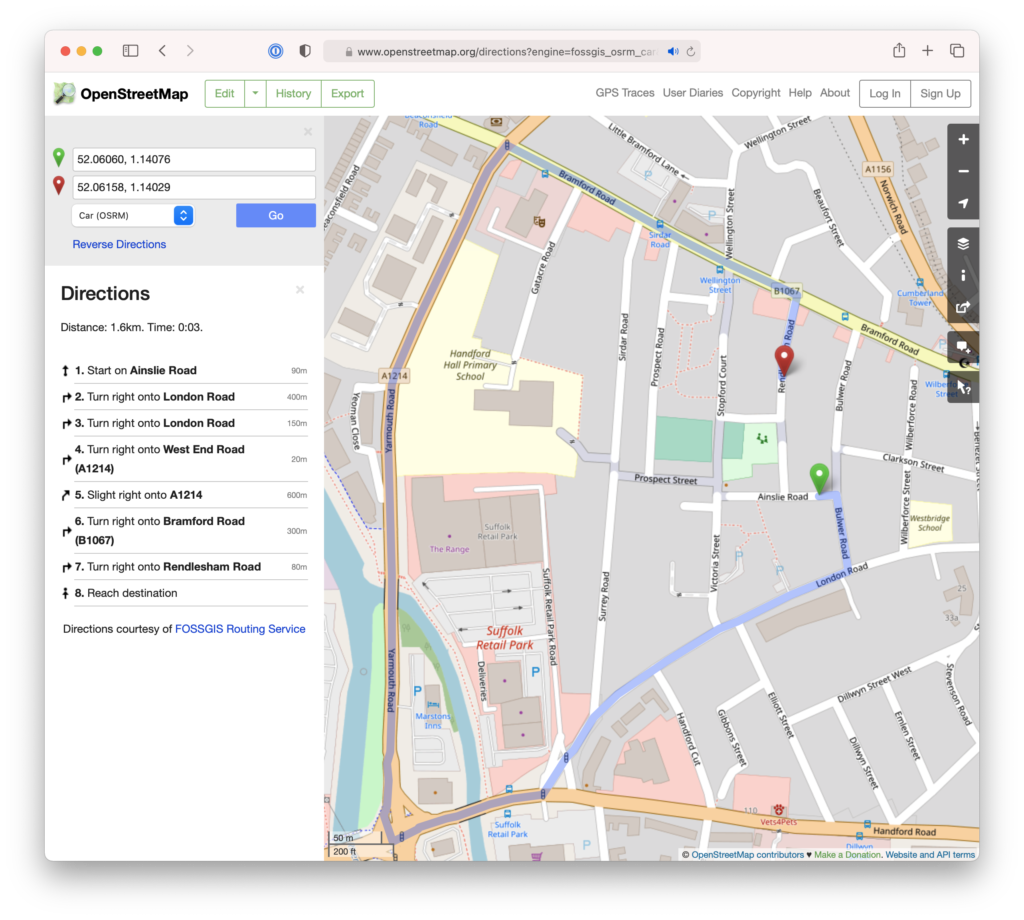
On the other hand walking or cycling is much more direct.

Another similar example is Ravenswood in the south west of Ipswich, where there is only a single private motor vehicle access, with the other motor vehicle access being a bus gate. Occasionally there is a suggestion about opening the bus gate to motor traffic, due to the congestion at the single motor vehicle access to the area, however it’s quickly shot down as would just generate yet more motor motor traffic and pollution. The real solution is improving the public transport and active travel infrastructure as they are far more efficient at moving people around than private motor vehicles.
There is a significant cycle to school rate, in part due to the cycle route through the estate, however private motor vehicle usage is still high with complaints of congestion. There needs to be a review of what’s stopping people from using the bus, walking, and cycling for their journeys off the estate. Does there need to be protected cycle tracks implemented on nearby roads such as Nacton Road, Ransomes Way, Felixstowe Road, and fast direct routes into the town centre and to the railway station? This network of cycle tracks would make people feel safe to cycle with shopping and children, and hopefully provide the mode shift to reduce the congestion.

Kesgrave is similar, with there being no through access between main roads, and any access will take you back to the same main road, thus there’s no incentive to cut through. Kesgrave high school also has the highest cycle to school rate in the country. How can we replicate this across the rest of the region/country?
All properties in a low traffic neighbourhood is accessible with a motor vehicle. Each property is normally only accessible from a single main road, whilst people who are walking, cycling, or using public transport. Emergency vehicle access is maintained, and evidence shows that the response times get faster after a low traffic neighbourhood is impelemented due to the reduced delays caused by motor vehicles.
Breaking car dependancy
To reduce carbon emissions from transport one of the areas that needs to be looked at is the issue of car dependancy. For this section, I’ll pose a series of questions.
Why is it seen as ok that people need to drive for so many journeys?
Why is it seen by many to be able to park on the pavement?
Why is it ok to for dropped kerbs to go the full width of the footway, making a horrible sideways wiggle when using mobility aids or trikes (where it’s shared use)?
Why can’t children travel independently like the used to be able in previous decades?
Why is it seen as acceptable that children can’t play in their street any more or travel and significant distance from home on own their own?
Why is public transport so expensive compared to the marginal cost of using a car?
Why isn’t cycling seen as a normal mode of transport for short journeys like in places such as The Netherlands, Denmark, and various other towns and cities that are implementing cycling infrastructure and making it hard to drive short distances? (The answer isn’t culture).
Why are there so few bikes available in bike shop that are good for utility cycling and carrying luggage?
Why is walking or cycling a few miles seen as a long distance that’s hard to do?
Why do we allow the pavements, that are meant to be for people to travel, to be used for the storage of metal boxes on wheels?
School Streets
The number of children who are driven to or from school has dramatically risen over recent decades. This is making the roads outside schools to become dangerous in terms of road safety, and also in terms of high levels of air pollution. The lack of exercise is also causing issues in terms of obesity, concentration level, and attainment.
School Streets opens the street directly outside the school gates (and sometimes neighbouring streets) to people who are walking, cycling, scooting, etc so that the parents and pupils don’t need to cram on to the pavement, which is ever more important during the current pandemic. Motor traffic to the street is normally restricted to a very limited set of vehicles (such as emergency vehicles, buses, and residents) during the hour or two per day when the road is needed for the school arrival and departure.
Residents often prefer having a restricted time of access to their property during the school arrival and departure times to the chaos of parents and carers parking on the pavements and grass verges. When school streets were first implemented in Edinburgh, there were lots of complaints from parents with children in other schools that their school was being included too.
Sustrans info on School Streets
Publicity photos/videos
In the UK cycling is often seen to be a sport rather than a mode of transport for general getting around or utility cycling, and this perception really needs to change urgently.
Photos and videos that are used to show people cycling in publicity should include more normal people cycling without plastic hats and other advisory, but not required clothing. I’d also like to see more photos of cargo bikes, people carrying shopping, and children on bikes to help show that it’s normal to carry shopping and children on a bike, and that it’s possible to do these very ordinary things without a car. This would make more people think that they could start cycling as the people in the pictures look like them, and are doing journey that they need to do. Many cargo bikes are now available in e-assist variants which makes it a lot easier to climb hills or move large amounts of luggage or more children with ease.
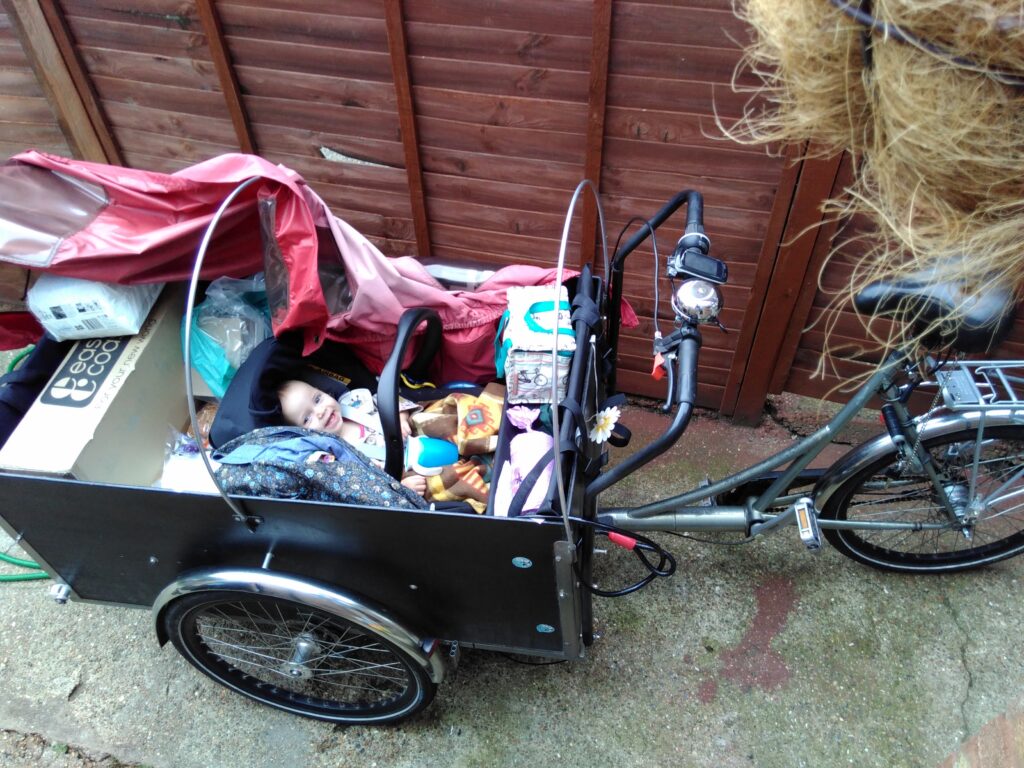
Try before you buy
Some local councils are providing cargo bikes on a one month trial so that people who live, work, or study in the area can see how it works before actually buying one. This is a good way to support families who want to use a car less.
Car clubs
Sometimes it’s just easier to use a car for some journeys. Rather than having everyone own their own vehicle and having to deal with the storage issue, which is particularly difficult in the centre of towns and cities, there is an alternative, which is a car club. These allow the use of a motor vehicle at short notice, and with an automated system compared to normal car hire. Vehicles are usually positioned across the town so that they are close to where the people live and are hopefully within walking distance.
Integrated public transport
The cost of public transport at the point of use is high and fares are complicated compared to the marginal cost of a car. There are multiple bus operators in Ipswich with minimal cross operator ticketing (primarily plus bus which also requires a train journey). Why can’t we have a tap and pay system with automatic capping, and the capping working across all operators?
Deliveries
Last mile deliveries in urban areas need to be moved to electric and/or pedal power similar to what Pedal me in London, and Zedify in several cities across the country including Brighton, Cambridge, Edinburgh, Glasgow, London, Norwich, Southampton, and Winchester, have done already. Zedify operate under a franchise model, and have shown an interest in having a base in Ipswich.
Pedal me also support passenger carriage, and specialised cargo deliveries and contracts. They are very vocal on Twitter about highlighting their employee training, pay (hourly rather than self employed pay per delivery that many delivery companies have moved to), and highlighting the various items that they are able to carry including comparing them to other other modes of transport.
Cycle deliveries can allow for a larger delivery window for pedestrianised zones, with them being setup to allow the cycle delivery access.
Regional
There are some items such as rail and how to travel between towns which needs to be looked at regionally.
Rail freight
At the regional or longer distance transport level there needs to be more capacity to move more freight on to the electrified rail network. This needs a rolling programme of electrification starting with Felixstowe to Peterborough, which will allow for electrified freight to travel from Felixstowe to the East Coast Mainline and beyond without going via London.
Passenger rail services
There needs to be an increase rail speeds on routes avoiding London so that journey times are reduced. The journey time between for example Ipswich and Cambridge (comparing the rail stations) by rail and car is about the same. Door to door time from housing in Ipswich to the northern employment zones of Cambridge is significantly different and I see the journey time on what should be a reasonable commute (after the pandemic) as the biggest factor at stopping people from shifting from driving to public transport on this corridor. The frequency of services is also a factor with it currently being hourly, a higher frequency in the peak could help with some of the modal shift.
What needs to be done to increase the line speeds between Stowmarket and Cambridge and Peterborough?
The new Stadler trains have noticeably faster acceleration when operating using the overhead wires compared the diesel power. This can help to reduce the journey times.
National and regional cycle routes
Cycling between towns in the regions isn’t particularly easy, especially if you are on a non standard bike, have children with you, or are doing a cycling tour holiday. It’s frustrating that I struggle with the idea of cycling with luggage to the port of Harwich, yet on the other side of the North Sea, I’ll happily cycle any distance given enough time. This is all down to a lack of quality walking and cycling infrastructure on key routes, without big diversions.
Being able to cycle to the next town is one of the things that needs to be considered to be able to help break the issue of car dependancy and discourage car use for journeys in the 5-20 mile range, which are easily doable on a bike.
Sustrans over recent years have got a lot of complaints due to the poor quality of the national cycle network. We don’t build motorways or major through A roads which turn to mud in the winter, or have pedestrians wandering over them, why do we allow this for cycle paths? Recently they have dropped sections which don’t meet a minimum standard. This is a good thing. How can councils help to bring the reduced network up to the newer minimum sped, and to expand the network further meeting the newer standard.
Stop road building projects
Building more roads just induces more demand, and more motor traffic in the longer term. There is generally only a short term reprieve in the level of motor vehicle congestion. I would recommend no more road building, with the exception of access roads into new buildings, until the mode share of walking, cycling, and public transport for journeys under 10 miles is over 70%. If The Netherlands is anything to go by, dual carriageways can end up getting downgraded due to the low usage by motor vehicles. Other cities have been known to do this too.
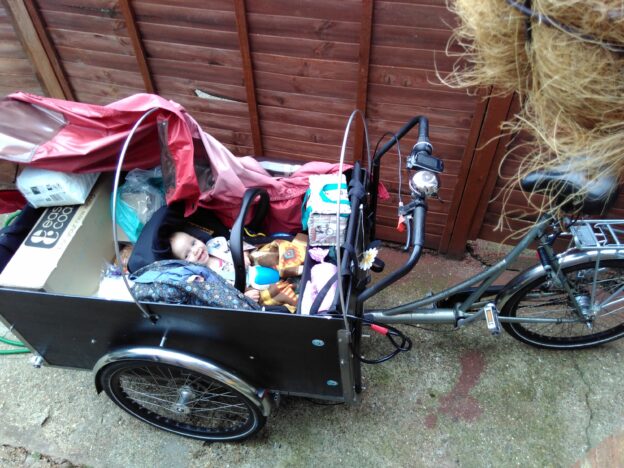
A useful tour of the issues. Any ideas on getting a Zedify franchise going in Ipswich?
Also re longer-distance commuting options, it’s worth mentioning the issues around limited bike space on the trains, shortage of secure cycle parking at stations (and its limited suitability for non-standard cycles), awkwardness of getting bikes, luggage, kids etc. on and off trains. Thinking about your family cycle tour to NL, the obvious way would be to take the train to Harwich, but I imagine you might feel a bit daunted by some of the challenges of doing that?
Also re long-distance commuting, my guess is that covid will have permanently accelerated the trend toward home working with only occasional trips to base, which I also guess will have a flatter time-of-day profile, so train operators should be able to get better overall utilisation, with a much better customer experience.